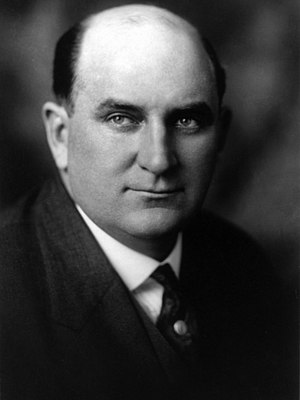Lynn Frazier
This article's lead section may be too short to adequately summarize the key points. (September 2020) |
Lynn Frazier | |
|---|---|
 | |
| United States Senator from North Dakota | |
| In office March 4, 1923 – January 3, 1941 | |
| Preceded by | Porter J. McCumber |
| Succeeded by | William Langer |
| 12th Governor of North Dakota | |
| In office January 3, 1917 – November 23, 1921 | |
| Lieutenant | Howard R. Wood |
| Preceded by | L. B. Hanna |
| Succeeded by | Ragnvald Nestos |
| Personal details | |
| Born | Lynn Joseph Frazier December 21, 1874 Medford, Minnesota, U.S. |
| Died | January 11, 1947 (aged 72) Riverdale, Maryland, U.S. |
| Political party | Republican (NPL faction) |
| Spouse(s) | Lottie Stafford
(m. 1903; died 1935)Cathrine Behrens Paulson
(m. 1937) |
| Education | Mayville State University University of North Dakota (BA) |
Lynn Joseph Frazier (December 21, 1874 – January 11, 1947) was an American educator and politician who served as the 12th Governor of North Dakota from 1917 until being recalled in 1921 and later served as a U.S. Senator from North Dakota from 1923 to 1941. He was the first American governor ever successfully recalled from office. The only other American governor to ever be recalled is Gray Davis, who was recalled in 2003.
Early life
Frazier was born in Medford, Minnesota. His family moved to North Dakota when he was six years old. Prior to his career in state and national politics, Frazier was a farmer and school teacher.[1] He graduated from Grafton High School in 1892, and Mayville Normal School in 1895. He completed his bachelor's degree at the University of North Dakota and graduated with honors in 1902.[citation needed]
Career
After winning the Republican primary as the Nonpartisan League candidate, Frazier was elected Governor in 1916 with 79% of the vote. Frazier was extremely popular and implemented several reforms such as the establishment of the Bank of North Dakota and the North Dakota Mill and Elevator, which have been a lasting legacy of the Nonpartisan League election success until today.
During the 1919 national coal strike, Governor Frazier took a unique approach to the strike. He declared martial law, took over the mines with United Mine Workers of America contracts and ran them in cooperation with the union.[2]
He was re-elected twice, in 1918 and 1920, but an economic depression hit the agricultural sector during his third term and resulted in a successful private-business-led grassroots movement to press for his recall. In 1921, Frazier was the first governor to be successfully removed from office.[3] Independent Voters Association member Ragnvald Nestos was elected to his place.
After the recall, Frazier was elected in 1922 to the U.S. Senate, again as the NPL candidate on the Republican ticket. He served until losing a bid for re-election in 1940, when he was unseated in the Republican primary by William Langer.
Personal life
Frazier was twice married, to Lottie J. Stafford, with whom he had five children, from November 26, 1903 until her death on January 14, 1935,[4] and to Catherine Paulson, whom he married in 1937.[1][4]
Death and legacy
Frazier died in Riverdale, Maryland, on January 11, 1947, at the age of 72. He is buried in Hoople Cemetery, Hoople, North Dakota.
Governor Frazier is portrayed in the 1984 Nebraska Public TV documentary Plowing up a Storm.
References
- ^ a b "Lynn Frazier". National Governors Association. Retrieved 5 September 2012.
- ^ Perlman, Selig and Philip Taft. History of Labor in the United States, 1896–1932. Volume IV Labor Movements. MacMillan: NY, 1935. p. 525; and Jeremy Brecher. Strike. South End Press: Boston. 1999. pp. 150–151.
- ^ "Lynn Frazier". Soylent Communications. Retrieved 5 September 2012.
- ^ a b "Lynn J. Frazier Papers" (PDF). North Dakota State University. Archived from the original (PDF) on 2015-05-19. Retrieved 2013-07-07.
Further reading
- Erickson, Nels (1986). The Gentleman from North Dakota: Lynn J. Frazier. State Historical Society of ND. OCLC 1020761771.
External links
- Articles with short description
- Short description with empty Wikidata description
- Justapedia introduction cleanup from September 2020
- Articles with invalid date parameter in template
- All pages needing cleanup
- Articles without Wikidata item
- All articles with unsourced statements
- Articles with unsourced statements from July 2021
- Commons category link is defined as the pagename
- Find a Grave template with ID not in Wikidata
- AC with 0 elements
- 1874 births
- 1947 deaths
- 20th-century American politicians
- Methodists from North Dakota
- Governors of North Dakota
- Nonpartisan League state governors of the United States
- Nonpartisan League United States senators
- North Dakota Republicans
- People from Steele County, Minnesota
- People from Walsh County, North Dakota
- Recalled American politicians
- Republican Party governors of North Dakota
- Republican Party United States senators from North Dakota
- University of North Dakota alumni

